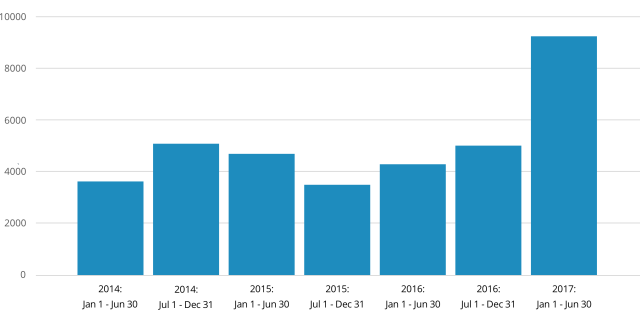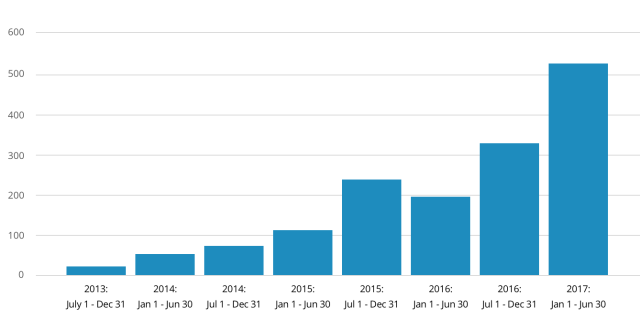
The time has come for the bi-annual update to our transparency report, covering January 1 to June 30, 2017. As usual, we’ve shared updated data about national security requests, government requests for user information, government demands for removal of content, as well as notices of copyright and trademark infringement. We’ve included some of the most interesting highlights below.
Intellectual Property
We received the highest number of DMCA takedown notifications in a single six-month reporting period. From the 5,006 we received between July-December 2016 to 9,273 this period, we saw an 85% increase.

The bulk of this increase comes down to just two complainants, both of which submitted over 2,000 reports each, accounting for 47% of the 9,273 total takedowns received. To truly appreciate the top two complainants’ volume, you should note that the third highest complainant submitted 371 reports.
We often received multiple copies of the same DMCA notice (sometimes days apart!), and often these duplicate notices target material that had already been removed or was hosted elsewhere. This highlights the problem with automated takedown systems that have no element of human review. We’ve written about the issues involved with DMCA takedown bots before, and the figures in this report suggest that the problem isn’t going away. The high volume of thoughtless takedown places a big burden on the small team we have, who are charged with carefully reviewing and processing our notices, to ensure the rights of copyright holders and our users are protected.
Due to the high volume of bot generated deficient takedown notices, we removed content in response to only 22% of the DMCA notices we received in this period, compared with our average of approximately 60% across the past six reporting periods.
Meanwhile, we can count on one hand the number of counter notices we received from our site owners, and it’s the fewest we’ve seen in a reporting period to date: 5. As we’ve mentioned, the counter notice process is intimidating and can lead to a user being sued in federal court, which means spending a tremendous amount in legal fees defending their case, even if the court determines the user’s material isn’t infringing.
Government Demands
We receive a steadily increasing number of takedown demands from governments around the world, with a 61% increase this reporting period compared to last’s.

Takedown demands from certain countries are particularly concerning. While Russia is sending us the greatest volume, we’re seeing especially problematic demands from the Turkish government, which actively censors content that criticizes the Turkish government, officials, and/or army. In hopes of defending the rights of our users to speak about their government, we have filed objections to 13 of the most egregious court orders. Unfortunately we have not seen much success. Eleven of our appeals have been rejected, and two are pending. Additionally, we do what we can to partner with our affected users in filing our objections — Turkish citizens who are blogging about their government. However this is very fraught territory, especially when filing an objection would be made in a user’s name. One of our users said it best: to appeal, and reveal their identity, would be “suicide.”
Further, after consulting with additional experts on Turkish law, we’ve learned that not only are the users who bring the case at risk, even the lawyers and judges in cases involving national security (for example, content that criticized military involvement and suggested military misconduct) can be charged for assisting terrorist organizations.
We will continue to fight for freedom of expression and our users in Turkey, which includes being as transparent as we can about the situation, the demands we receive, and our response to them.
National Security
We recently shared some information about the process we followed to lift the nondisclosure restrictions associated with five NSLs received in previous years and provide copies of our correspondence with the government. We hope this information will be useful to other companies who may wish to take advantage of the legal options that are currently available to challenge NSL nondisclosure orders.
We’ve also developed a form reciprocal notice request. If your company has received an NSL in the past and you would like the government to review the letter’s nondisclosure requirement, this form may be useful to you.
As always, please take a look through the data, and let us know if you have any questions or other types of data that you’d like to see in future reports!